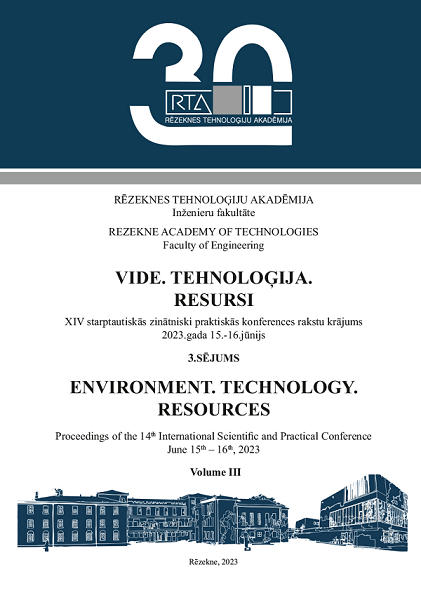APPLICATION OF A FINITE ELEMENT MODEL TO OBTAIN THE INFLUENCE OF THE TREATMENT’S POWER, REFLECION AND FOCAL DIAMETER IN LASER TEXTURING OF ALUMINUM
DOI:
https://doi.org/10.17770/etr2023vol3.7278Keywords:
laser texturing, pure aluminum, finite element method (FEM), vaporized zoneAbstract
In this work, a numerical model of laser texturing is considered. A finite element model of a representative sample of pure aluminum was created. The impact of a laser pulse was simulated, assuming a Gaussian volume distribution of the heat flux. Material properties are assumed to be constant and latent heat is accounted for. Results are obtained for the thermal field and the width of the vaporized zone, assuming that the crater is characterized by its maximum width. The numerical model was used to study the influence of pulse power density, reflection, focal diameter and pulse duration. The ablation threshold at different laser pulse durations was determinate.
References
D. Förster, B. Jëggi, A. Michalowski, B. Neuenschwander. Review on Experimental and Theoretical Investigations of Ultra-Short Pulsed Laser Ablation of Metals with Burst Pulses. Materials 14, 3331, 2021,
http://dx.doi.org/10.3390/ma14123331.
A. Rosenkranz, P. Grützmacher, C. Gachot. H. Costa. Surface Texturing in Machine Elements – A Critical Discussion for Rolling and Sliding Contacts. Advanced Engineering Materials, 1900194, 2019,
http://dx.doi.org/10.1002/adem.201900194.
S. Liu, Z. Tian, L. Shen, M. Qiu. Numerical Simulation and Experimental Investigation of Laser Ablation of Al2O3 Ceramic Coating. Materials 13, 5502, 2020,
http://dx.doi.org/10.3390/ma13235502.
H. D. Vora, N. Dahotre. Multiphysics Theoretical Evaluation of Thermal Stresses in Laser Machined Structural Alumina. Laser Manuf. Mater. Process, 2:1-23, 2015,
http://dx.doi.org/10.1007/s40516-014-0004-x.
L. Lazov, N. Angelov. Optimization of laser marking with the help of simulation models. Turkish Journal of Physics, 37, pp. 145-150, 2013,
http://dx.doi.org/10.3906/fiz-1202-4.
T. Moriya, K. Fukumitsu, T. Yamashita, M. Watanabe. Fabrication of Finely Pitched LYSO Arrays Using Subsurface Laser Engraving Technique with Picosecond and Nanosecond Pulse Lasers. IEEE Transactions on nuclear science, Vol. 61, No. 2, pp. 1032-1037, 2014,
http://dx.doi.org/10.1109/TNS.2014.2309347.
J. Lopez, F. Deloison, A. Lidolff, M. Delaigue, C. Hönninger, E. Mottay. Comparison of picosecond and femtosecond laser ablation for surface engraving of metals and semiconductors. Key Engineering Materials, Vol. 496, pp. 61-66, 2012,
http://dx.doi.org/10.1117/12.907792.
B. Wang, Y. Huang, J. Jiao, H. Wang, J. Wang, W. Zhang, L. Sheng. Numerical Simulation on Pulsed Laser Ablation of the Single-Cristal Superalloy Considering Material Moving Front and Effect of Comprehensive Heat Dissipation. Micromachines, 12, 225, 2021,
http://dx.doi.org/10.3390/mi12020225.
Q. Guo, Y. Ma, Z. Wu, Y. Cui, C. Yang. Finite Element Analysis and Experimental Research on Micro-treatment of Coniferous Wood Surface. Chemical Engineering Transactions, Vo. 55, pp. 91-96, 2016,
https://doi.org/10.3303/CET1655016.
Y. Wang, D. W. Hahn. A simple element model to study the effect of plasma plume expansion on the nanosecond pulsed laser ablation aluminum. Applied Physics A, 125:654, 2019,
https://doi.org/10.1007/s00339-019-2951-8.
M. Pantawane, S. Joshi, N. Dahotre. Laser Beam Machining of Aluminum and Aluminum Alloys. ASM Handbook, Vol. 2A, pp. 519-541, 2018,
http://dx.doi.org/10.31399/asm.hb.v02a.9781627082075.
Y. Wang, O. Zhupanska, C. Pasiliao. Verification of a Manual Mesh Moving Finite Element Analysis Procedure for Modeling in Laminated Composite Materials. Proccedings of the ASME IMECE2017-70623, 2017,
http://dx.doi.org/10.1115/IMECE2017-70623.
Y. Wang, T. Risch, C. Pasiliao. Modeling of Pyrolyzing Ablation Problem with ABAQUS: A One-Dimensional Test Case. Journal of Thermophysics and Heat Transfer, pp. 1-4, 2018,
http://dx.doi.org/10.2514/1.T5274.
H. Karbasi. COMSOL Assisted Simulation of Laser Engraving. COMSOL Conference 2010 Boston, 2010.
H. D. Vora, S. Santhanakrishnan, S. Harimkar, S. K. Boetcher, N. Dahotre. One-dimensional multipulse laser machining of structural alumina: evolution of surface topography. Int J Adv Manuf Technol 68, pp. 69-83, 2013,
https://doi.org/10.1007/s00170-012-4709-8.
E. Nikolidakis, A. Antoniadis. FEM modeling simulation of laser engraving. The International Journal of Advanced Manufactoring Technology 105, pp. 3489–3498, 2019, https://doi.org/10.1007/s00170-019-04603-3.
J. Kuang, T. Hung, K. Lai, C. Hsu, A. Lin. The Surface Absorption Coefficient of S304L Stainless Steel by Nd:YAG Micro-Pulse Laser. Advanced Material Research, Vol. 472-475, pp. 2531-3534, 2012,
http://dx.doi.org/10.4028/www.scientific.net/AMR.472-475.2531.
H. D. Vora, N. Dahorte. Laser Machining of Structural Alumina: Influence of Moving Laser Beam on the Evolution of Surface Topography. Int. J. Appl. Ceram. Technol., pp. 1-14, 2014.
H. D. Vora, S. Santhanakrishnan, S. Harimkar, S. Boetcher, N. Dahotre. Evolution of surface topography in one-dimensional laser machining of structural alumina. Journal of the European Ceramic Society 32, pp. 4205-4218, 2012,
http://dx.doi.org/10.1016/j.jeurceramsoc.2012.06.015.
A. Otto, H. Koch, K. Leitz, M. Schmidt. Numerical Simulations – A Versatile Approach for Better Understanding Dynamics in Laser Material Processing. Physics Procedia 12, pp. 11-20, 2011,
http://dx.doi.org/10.1016/j.phpro.2011.03.003.
G. Chryssolouris Laser machining theory and practice. New York: Springer- Verlag; 1991.
J. Liu. Simple technique for measurements of pulsed Gaussian-beam spot sizes. Opt. Lett. 7, pp. 196-198, 1982.
M. Pantawane, S .Joshi, N. Dahotre. Laser Beam Machining of Aluminum and Aluminum Alloys. ASM Handbook, Vol. 2A, Aluminum Science and Technology, pp. 519-541, 2018,
http://dx.doi.org/10.31399/asm.hb.v02a.9781627082075.
E. Beyer. Schweissen mit Laser, Berlin: Springer, pp. 28–36, 1995.
A. M. Lehmuskero, M. Kuittinen, P. Vahimaa. Refractive index and extinction coefficient dependence of thin Al and Ir films on deposition technique and thickness. OPTICS EXPRESS, Vol. 15, No. 17, 2007,
http://dx.doi.org/10.1364/OE.15.010744.
F. Hamadi, E. Amara, D. Bennaceur-Doumaz, R. Boutaka, H. Kellou, K. Bourai, A. Noukaz, R. Beggar. Modeling of Titanium Oxide Layer Growth Produces by Fiber Laser Beam. Defect and Diffusion Forum Vol. 336, pp. 11-18, 2013,
https://doi.org/10.4028/www.scientific.net/DDF.336.11.
D. Bergström, A. Kaplan, J. Powell. Mathematical Modelling of Laser Absorption Mechanisms in Metals: A Review. M4PL16 - 16th Meeting on Mathematical Modelling of Materials Processing with Lasers, 2003.
ABAQUS, “Analysis User’s Manual,” ver. 6.14, Dassault Systemes Simulia Corp., Providence, RI, USA.



